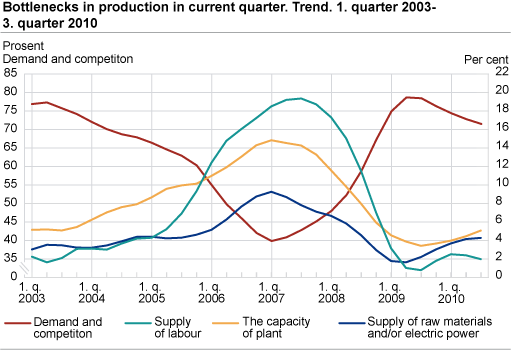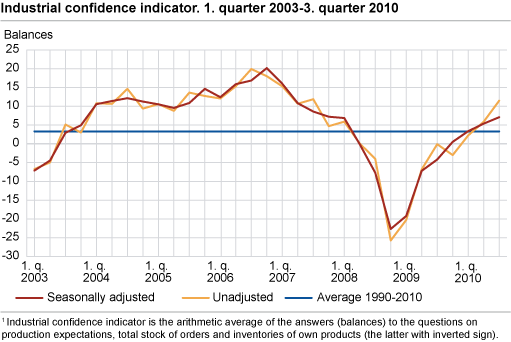Content
Published:
This is an archived release.
Gradual improvement for manufacturing
Norwegian industrial managers report a positive development in the business cycle, and further improvement is expected in the fourth quarter. Prospects of a rise in new orders from home and export support this view.
According to the business tendency survey, the Norwegian manufacturing industry experienced moderate growth in total output in the third quarter of 2010. Improved conditions in home and export markets explain this result. The growth in demand had a positive effect on market prices, which ceased falling. However, poor demand and fierce competition still played a major role in restricting production, and employment continued to fall. The number of working months covered by the current stock of orders is somewhat higher than in 2009. The same development is recorded for average capacity utilisation, which is estimated at 78.5 per cent. International comparisons of average capacity utilisation are available from EUROSTAT .
Prospects of further growth in total output
Norwegian industrial managers consider the general short-term outlook (Q4 2010) to be positive. Prospects of further growth in output and new orders received support this view. The industrial confidence indicator has risen from 5 to 7 (seasonally-adjusted net figure). The result implies a somewhat stronger growth in output in the fourth quarter of 2010. International comparisons of the industrial confidence indicator are available from EUROSTAT (EU), the Swedish National Institute of Economic Research (Sweden) and Statistics Denmark .
Increased demand for intermediate goods
Sectors producing intermediate goods (wood and wood products, paper and paper products, non-metallic mineral products, basic metals etc.) experienced further growth in total output, and the decline in employment came to a halt. A rise in new orders from home and export markets explains this development. The growth in demand had a positive effect on market prices, which improved in the third quarter. The number of working months covered by the current stock of orders was somewhat higher than recorded in the second quarter. Average capacity utilisation is estimated at 80 per cent.
The general short-term outlook is considered to be positive. Prospects of further growth in output, new orders and market prices support this result.
Further reduction in output for producers of capital goods
Sectors producing capital goods (machinery and equipment, ships, boats and oil platforms etc.) experienced a further reduction in output and employment. However, fewer managers report negative results, and the fall in total stocks of orders showed signs of levelling out. A rise in new orders from domestic markets explains this development. Market prices continued to fall in the third quarter. The number of working months covered by the current stock of orders was close to the historic average, while average capacity utilisation is estimated at 79.8 per cent.
The indicator covering the general short-term outlook is changing from neutral to positive. Prospects of a rise in new orders support this result.
Higher prices on consumer goods
Sectors producing consumer goods (food products, printing and reproduction, basic pharmaceuticals, furniture etc.) experienced further growth in output. Employment, however, continued to fall. Structural changes (fewer and bigger production plants) within the food and beverages sector contributed to this decline. Demand in domestic markets was somewhat weaker than before, while demand in export markets was somewhat stronger. Market prices continued to improve in the third quarter. Average capacity utilisation is estimated at 75.6 per cent. The result is more or less unchanged from the previous survey.
The general short-term outlook is considered to be positive. Prospects of a further rise in output and demand explain this result.
| Industry | Prospects | Background | |||||||||||||||||||||||||||||||||||||||||||||||||||||||||||||||||||||||||||||
|---|---|---|---|---|---|---|---|---|---|---|---|---|---|---|---|---|---|---|---|---|---|---|---|---|---|---|---|---|---|---|---|---|---|---|---|---|---|---|---|---|---|---|---|---|---|---|---|---|---|---|---|---|---|---|---|---|---|---|---|---|---|---|---|---|---|---|---|---|---|---|---|---|---|---|---|---|---|---|---|
| Food, beverages and tobacco | + | Higher levels of production and capacity utilisation in Q3. Growth in demand from the domestic and export markets. Increase in market prices. The general outlook for Q4 is considered to be positive. Expectations of positive development in output, demand and market prices. | |||||||||||||||||||||||||||||||||||||||||||||||||||||||||||||||||||||||||||||
| Wood and wood products | ++ | Growth in output, capacity utilisation and employment. New orders from the domestic market have increased, while new orders from the export market are reduced. Growth in market prices. The general outlook for Q4 is judged as better by many managers. Expectations of further growth in output, new orders from the domestic market and market prices. | |||||||||||||||||||||||||||||||||||||||||||||||||||||||||||||||||||||||||||||
| Paper and paper products | + | More or less unchanged level of production. Reduced capacity utilisation and employment. New orders from the export market have increased. Increase in market prices. The general outlook is considered to be positive, and the levels of output and market prices are expected to rise in Q4. Further growth in new orders from the export market is also expected. | |||||||||||||||||||||||||||||||||||||||||||||||||||||||||||||||||||||||||||||
| Basic chemicals | ++ | Many managers report higher levels of production and capacity utilisation. Growth in employment. Increase in new orders and market prices. Shortage of capacity is a limiting factor for production, and the average number of working months covered by the current stock of orders has risen. Many managers judge the general outlook for Q4 as better, and there are expectations of growth in output, new orders and market prices. | |||||||||||||||||||||||||||||||||||||||||||||||||||||||||||||||||||||||||||||
| Non-ferrous metals | +(-) | More or less unchanged level of production. Decline in the level of employment and new orders. Increase in export prices. The general outlook for Q4 is considered to be positive. Expectations of growth in output and new orders. | |||||||||||||||||||||||||||||||||||||||||||||||||||||||||||||||||||||||||||||
| Fabricated metal products | -(+) | More or less unchanged levels of production and stock of orders. Reduced level of employment. Decline in market prices. The general outlook for Q4 is judged as better, and there are expectations of growth in output and new orders from the domestic market in the forthcoming quarter. | |||||||||||||||||||||||||||||||||||||||||||||||||||||||||||||||||||||||||||||
| Computer and electrical equipment | +(-) | More or less unchanged levels of production and capacity utilisation. Reduced employment. Decline in market prices. Many managers report increase in new orders and the general outlook for Q4 is considered to be better. Expectations of growth in output, capacity utilisation and new orders. A further decline in market prices is expected. | |||||||||||||||||||||||||||||||||||||||||||||||||||||||||||||||||||||||||||||
| Machinery and equipment | -(+) | Decline in output, capacity utilisation and employment. More or less unchanged level of new orders and reduced market prices. The general outlook for Q4 is judged as positive. Expectations of unchanged level of output and increase in new orders. Decline in market prices is expected. | |||||||||||||||||||||||||||||||||||||||||||||||||||||||||||||||||||||||||||||
| Ships, boats and oil platforms | -(+) | Reduction in output, capacity utilisation and employment in Q3. Decline in new orders and market prices. The general outlook for Q4 is considered to be neutral. Expectations of unchanged level of production, while employment and new orders are expected to increase in Q4. A further reduction in market prices is expected. | |||||||||||||||||||||||||||||||||||||||||||||||||||||||||||||||||||||||||||||
| Repair, installation of machinery | -(+) | Decline in output, capacity utilisation and employment in Q3. More or less unchanged level of new orders from the domestic market, while new orders from the export market are reduced. Decline in market prices. Many managers consider the general outlook for Q4 to be positive. Expectations of growth in output and new orders. Reduction in market prices is expected. | |||||||||||||||||||||||||||||||||||||||||||||||||||||||||||||||||||||||||||||
| The column for Prospects shows an overall evaluation of the present situation and expected short-term developments using the symbols + and -. The following codes and constellations are used: |
++
+ ² - -- +(-) +/- |
Very good
Good Stable Poor Very poor Good, but with certain negative indications A situation where the + and - factors even out. |
|||||||||||||||||||||||||||||||||||||||||||||||||||||||||||||||||||||||||||||
Industrial confidence indicator (ICI)The indicator is the arithmetic average of the responses (balances) to the questions on production expectations, total stock of orders and inventories of own products (the latter with an inverted sign). The indicator is a guide to the level of industrial production since:
TimelinessThe survey data was collected in the period between 10 September 2010 and 20 October 2010. |
Extended release of results in the StatBank:The coverage in the Statbank is substantially extended from the release of results for the Business tendency survey in the third quarter of 2010. Five new tables are available: 08264: Business tendency survey. Tendencies 08265: Business tendency survey. Judgements 08266: Business tendency survey. Limiting factors for production 08267: Business tendency survey. Composit indicators 08268: Business tendency survey. Response distribution for selected indicators, by industry division The new tables also cover results from the former table in the Statbank: 07166: Business Tendency Survey (diffusion index), SIC2007. This table is therefore removed. |
Additional information
The statistics provide current data on the business cycle for manufacturing, mining and quarrying by collecting business leaders’ assessments of the economic situation and the short term outlook.
Contact
-
Edvard Andreassen
E-mail: edvard.andreassen@ssb.no
tel.: (+47) 40 90 23 32
-
Ståle Mæland
E-mail: stale.maeland@ssb.no
tel.: (+47) 95 05 98 88


